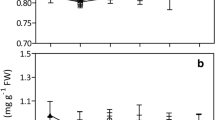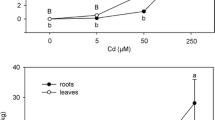Abstract
Mixed inorganic and organic contaminations are one of the main challenges in phytoremediation, due to the higher complexity derived by pollutant interactions and the increase of phytotoxicity. The cultivation of fast-growing poplars for removing contaminants from water could be a low-cost and flexible choice. The main objective of this study was to evaluate the tolerance of a poplar species (Populus alba ‘Villafranca’ clone) to irrigation with water contaminated with zinc (Zn) and caffeine (CFN). Poplars were maintained in hydroponic and exposed to four different treatments (Control, CFN, Zn and Zn + CFN) over 7 days. Poplar showed a good tolerance to Zn and CFN treatments, without any symptom of phytotoxicity. However, the type of treatment affected the contaminant dynamics in the plant-water system and a pollutant partitioning was observed among organs, with a higher accumulation of Zn in root (472 ± 128.7 mg kg− 1 DW) and CFN in shoot (30 ± 4.5 µg g− 1 FW). Under mixed condition, the CFN uptake significantly increased in root (+ 40%) and stem (+ 28%) while the Zn concentration decreased in leaves (-19%). A focus on the potential role of natural resistance-associated macrophage proteins (NRAMPs) in divalent metal transport has been performed. A down-regulation of NRAMP1.3 was detected in roots of plants exposed to CFN treatment in relation to an increase of Mn concentration. Data confirmed the suitability of Populus alba for the remediation of multi contaminated water.






Similar content being viewed by others
References
Agorio A, Giraudat J, Bianchi MW, Marion J, Espagne C, Castaings L, Lelièvre F, Curie C, Thomine S, Merlot S (2017) Phosphatidylinositol 3-phosphate–binding protein AtPH1 controls the localization of the metal transporter NRAMP1 in Arabidopsis. Proc Natl Acad Sci USA 114(16):E3354–E3363
Ahmad P, Abdel Latef AA, Abd Allah EF, Hashem A, Sarwat M, Anjum NA, Gucel S (2016) Calcium and potassium supplementation enhanced growth, osmolyte secondary metabolite production, and enzymatic antioxidant machinery in cadmium-exposed chickpea (Cicer arietinum L.). Front Plant Sci 7:513
Ali H, Khan E, Sajad MA (2013) Phytoremediation of heavy metals—concepts and applications. Chemosphere 91(7):869–881. https://doi.org/10.1016/j.chemosphere.2013.01.075
Alkhatib R, Alkhatib B, Al-Quraan N, Al-Eitan L, Abdo N, Muhaidat R (2016) Impact of exogenous caffeine on morphological, biochemical, and ultrastructural characteristics of Nicotiana tabacum. Biol Plantarum 60(4):706–714. https://doi.org/10.1007/s10535-016-0600-z
Anju M (2017) Biotechnological strategies for remediation of toxic metal(loid)s from environment. In: Gahlawat SK, Salar RK, Siwach P, Duhan JS, Kumar S, Kaur P (eds) Plant Biotechnol. Springer, Singapore, pp 315–359
Arnon DI, Hoagland DR (1940) Crop production in artificial culture solutions and in soils with special reference to factors influencing yields and absorption of inorganic nutrients. Soil Sci 50:463–485
Audet P, Charest C (2008) Allocation plasticity and plant–metal partitioning: meta-analytical perspectives in phytoremediation. Environ Pollut 156(2):290–296. https://doi.org/10.1016/j.envpol.2008.02.010
Bartrons M, Peñuelas J (2017) Pharmaceuticals and personal-care products in plants. Trends Plant Sci 22(3):194–203. https://doi.org/10.1016/j.tplants.2016.12.010
Brunner AM, Yakovlev IA, Strauss SH (2004) Validating internal controls for quantitative plant gene expression studies. BMC Plant Biol 4:14. https://doi.org/10.1186/1471-2229-4-14
Cailliatte R, Schikora A, Briat JF, Mari S, Curie C (2010) High affinity manganese uptake by the metal transporter NRAMP1 is essential for Arabidopsis growth in low manganese conditions. Plant Cell 22:904–917. https://doi.org/10.1105/tpc.109.073023
Chen YX, Lin Q, He YF, Tian GM (2004) Behavior of Cu and Zn under combined pollution of 2,4-dichlorophenol in the planted soil. Plant Soil 261(1–2):127–134. https://doi.org/10.1023/B:PLSO.0000035581.92021.f2
Chigbo C, Batty L, Bartlett R (2013) Interactions of copper and pyrene on phytoremediation potential of Brassica juncea in copper–pyrene co-contaminated soil. Chemosphere 90(10):2542–2548. https://doi.org/10.1016/j.chemosphere.2012.11.007
Chigbo C, Nnadi EO (2014) Exploring potential of using phytoremediation for co-contaminated soils. In: Gupta DK, Chatterjee S (eds) Heavy Metal Remediation: Transport and Accumulation in Plants. Nova Science Pub Inc, UK, pp 201–217
Chirakkara RA, Cameselle C, Reddy KR (2016) Assessing the applicability of phytoremediation of soils with mixed organic and heavy metal contaminants. Rev Environ Sci Bio 15(2):299–326. https://doi.org/10.1007/s11157-016-9391-0
Christofilopoulos S, Syranidou E, Gkavrou G, Manousaki E, Kalogerakis N (2016) The role of halophyte Juncus acutus L. in the remediation of mixed contamination in a hydroponic greenhouse experiment. J Chem Technol Biotechnol 91(6):1665–1674. https://doi.org/10.1002/jctb.4939
Curie C, Alonso J, Jean M, Ecker J, Briat JF (2000) Involvement of NRAMP1 from Arabidopsis thaliana in iron transport. Biochem J 347:749–755
Fu F, Wang Q (2011) Removal of heavy metal ions from wastewaters: a review. J Environ Manag 92(3):407–418. https://doi.org/10.1016/j.jenvman.2010.11.011
Gahlawat SK, Salar RK, Siwach P, Duhan JS, Kumar S, Kaur P (2017) Plant biotechnology: recent advancements and developments. Springer, Singapore
Gao H, Xie W, Yang C, Xu J, Li J, Wang H, Chen X, Huang CF (2018) NRAMP2, a trans-Golgi network-localized manganese transporter, is required for Arabidopsis root growth under manganese deficiency. New Phytol 217:179–193. https://doi.org/10.1111/nph.14783
Hechmi N, Aissa NB, Abdenaceur H, Jedidi N (2014) Evaluating the phytoremediation potential of Phragmites australis grown in pentachlorophenol and cadmium co-contaminated soils. Environ Sci Pollut Res 21(2):1304–1313. https://doi.org/10.1007/s11356-013-1997-y
Kolayli S, Ocak M, Kucuk M, Abbasoǧlu R (2004) Does caffeine bind to metal ions? Food Chem 84(3):383–388. https://doi.org/10.1016/S0308-8146(03)00244-9
Lanquar V, Lelièvre F, Bolte S, Hamès C, Alcon C, Neumann D, Vansuyt G, Curie C, Schröder A, Krämer U, Barbier-Brygoo H, Thomine S (2005) Mobilization of vacuolar iron by AtNRAMP3 and AtNRAMP4 is essential for seed germination on low iron. Embo J 24:4041–4051
Lanquar V, Ramos MS, Lelièvre F, Barbier-Brygoo H, Krieger-Liszkay A, Krämer U, Thomine S (2010) Export of vacuolar manganese by AtNRAMP3 and AtNRAMP4 is required for optimal photosynthesis and growth under manganese deficiency. Plant Physiol 152:1986–1999. https://doi.org/10.1104/pp.109.150946
Lin Q, Wang Z, Ma S, Chen Y (2006) Evaluation of dissipation mechanisms by Lolium perenne L, and Raphanus sativus for pentachlorophenol (PCP) in copper co-contaminated soil. Sci Total Environ 368(2–3):814–822. https://doi.org/10.1016/j.scitotenv.2006.03.024
Lloyd G, McCown B (1981) Commercially—feasible micropropagation of Mountain laurel, Kolmialatifolia, by use of shoot tip culture. Int Plant Propagators Soc 30:421–427
Luo Y, Guo W, HaoNgo H, DucNghiem L, IbneyHai F, Zhang J, Liang S, Wang XC (2014) A review on the occurrence of micropollutants in the aquatic environment and their fate and removal during wastewater treatment. Sci Total Environ 473:619–641. https://doi.org/10.1016/j.scitotenv.2013.12.065
Martínez-Hernández V, Leal M, Meffe R, De Miguel Á, Alonso-Alonso C, De Bustamante I, Lillo J, Martín I, Salas JJ (2018) Removal of emerging organic contaminants in a poplar vegetation filter. J Hazard Mater 342:482–491. https://doi.org/10.1016/j.jhazmat.2017.08.035
Meena RAA, Sathishkumar P, Ameen F, Yusoff ARM, Gu FL (2018) Heavy metal pollution in immobile and mobile components of lentic ecosystems-a review. Environ Sci Pollut Res. https://doi.org/10.1007/s11356-017-0966-2
Nagajyoti PC, Lee KD, Sreekanth TVM (2010) Heavy metals, occurrence and toxicity for plants: a review. Environ Chem Lett 8(3):199–216. https://doi.org/10.1007/s10311-010-0297-8
Pajević S, Borišev M, Nikolić N, Krstić B, Pilipović A, Orlović S (2009) Phytoremediation capacity of poplar (Populus spp.) and willow (Salix spp.) clones in relation to photosynthesis. Arch Biol Sci 61(2):239–247. https://doi.org/10.2298/ABS0902239P
Pallara G, Giovannelli A, Traversi ML, Camussi A, Racchi ML (2012) Effect of water deficit on expression of stress-related genes in the cambial region of two contrasting poplar clones. J Plant Growth Regul 31:102–112. https://doi.org/10.1007/s00344-011-9223-y
Pfaffl MW (2001) A new mathematical model for relative quantification in real-time RT–PCR. Nucleic Acids Res 29:e45. https://doi.org/10.1093/nar/29.9.e45
Pierattini EC, Francini A, Raffaelli A, Sebastiani L (2016a) Morpho-physiological response of Populus alba to erythromycin: a timeline of the health status of the plant. Sci Total Environ 569–570:540–547. https://doi.org/10.1016/j.scitotenv.2016.06.152
Pierattini EC, Francini A, Raffaelli A, Sebastiani L (2016b) Degradation of exogenous caffeine by Populus alba and its effects on endogenous caffeine metabolism. Environ Sci Pollut Res 23(8):7298–7307. https://doi.org/10.1007/s11356-015-5935-z
Pierattini EC, Francini A, Huber C, Sebastiani L, Schröder P (2018a) Poplar and diclofenac pollution: a focus on physiology, oxidative stress and uptake in plant organs. Sci Total Environ 636:944–952. https://doi.org/10.1016/j.scitotenv.2018.04.355
Pierattini EC, Francini A, Raffaelli A, Sebastiani L (2018b) Surfactant and heavy metal interaction in poplar: a focus on SDS and Zn uptake. Tree Physiol 1:109–118. https://doi.org/10.1093/treephys/tpx155
Pilipović A, Orlović S, Rončević S, Nikolić N, Župunski M, Spasojević J (2015) Results of selection of poplars and willows for water and sediment phytoremediation. Agric For 61:205–211. https://doi.org/10.17707/AgricultForest.61.4.23
Radulescu C, Stihi C, Popescu IV, Dulama ID, Chelarescu ED, Chilian A (2013) Heavy metal accumulation and translocation in different parts of Brassica oleracea L. Rom J Phys 58(9–10):1337–1354
Rigueto CVT, Nazari MT, De Souza CF, Cado JS, Brião VB, Piccin JS (2020) Alternative techniques for caffeine removal from wastewater: an overview of opportunities and challenges. J Water Process Eng 35:101231. https://doi.org/10.1016/j.jwpe.2020.101231
Rivera-Utrilla J, Sánchez-Polo M, Ferro-García M, Prados-Joya G, Ocampo-Pérez R (2013) Pharmaceuticals as emerging contaminants and their removal from water. A review. Chemosphere 93(7):1268–1287. https://doi.org/10.1016/j.chemosphere.2013.07.059
Romeo S, Francini A, Ariani A, Sebastiani L (2014) Phytoremediation of Zn: identify the diverging resistance, uptake and biomass production behaviours of poplar clones under high zinc stress. Water Air Soil Pollut 225:1813–1819. https://doi.org/10.1007/s11270-013-1813-9
Romeo S, Francini A, Sebastiani L, Morabito D (2017) High Zn concentration does not impair biomass, cutting radial growth, and photosynthetic activity traits in Populus alba L. J Soils Sediments 17(5):1394–1402. https://doi.org/10.1007/s11368-015-1251-y
Schwarzenbach RP, Escher BI, Fenner K, Hofstetter TB, Johnson CA, Von Gunten U, Wehrli B (2006) The challenge of micropollutants in aquatic systems. Science 313(5790):1072–1077. https://doi.org/10.1126/science.1127291
Shamsi IH, Jiang L, Wei K, Jilani G, Hua S, Zhang GP (2010) Alleviation of cadmium toxicity in soybean by potassium supplementation. J Plant Nutr 33(13):1926–1938. https://doi.org/10.1080/01904167.2010.512052
Sui Q, Cao X, Lu S, Zhao W, Qiu Z, Yu G (2015) Occurrence, sources and fate of pharmaceuticals and personal care products in the groundwater: a review. Emerg Contam 1(1):14–24. https://doi.org/10.1016/j.emcon.2015.07.001
Sun Y, Zhou Q, Xu Y, Wang L, Liang X (2011) Phytoremediation for co-contaminated soils of benzo[a]pyrene (B[a]P) and heavy metals using ornamental plant Tagetes patula. J Hazard Mater 186(2–3):2075–2082. https://doi.org/10.1016/j.jhazmat.2010.12.116
Takahashi R, Ishimaru Y, Senoura T, Shimo H, Ishikawa S, Arao T, Nakanishi H, Nishizawa NK (2011) The OsNRAMP1 iron transporter is involved in Cd accumulation in rice. J Exp Bot 62:4843–4850. https://doi.org/10.1093/jxb/err136
Traversari S, Francini A, Traversi ML, Emiliani G, Sorce C, Sebastiani L, Giovannelli A (2018) Can sugar metabolism in the cambial region explain the water deficit tolerance in poplar? J Exp Bot 69:4083–4097. https://doi.org/10.1093/jxb/ery195
Vannucchi F, Francini A, Pierattini EC, Raffaelli A, Sebastiani L (2019) Populus alba dioctyl phthalate uptake from contaminated water. Environ Sci Pollut Res 26(25):25564–25572. https://doi.org/10.1007/s11356-019-05829-0
Yang Y, Ok YS, Kim KH, Kwon EE, Tsang YF (2017) Occurrences and removal of pharmaceuticals and personal care products (PPCPs) in drinking water and water/sewage treatment plants: a review. Sci Total Environ 596:303–320. https://doi.org/10.1016/j.scitotenv.2017.04.102
Zhang H, Dang Z, Zheng LC, Yi XY (2009) Remediation of soil co-contaminated with pyrene and cadmium by growing maize (Zea mays L.). Int J Environ Sci Technol 6(2):249–258. https://doi.org/10.1007/BF03327629
Acknowledgements
Financial support was provided by the scholarships granted by Agrobiosciences PhD program at Scuola Superiore Sant’Anna of Pisa to FV and by PiAnta project granted by Regione Toscana, POR FESR 2014-2020.
Author information
Authors and Affiliations
Contributions
LS and AF contributed to the planning of the experiment, data elaboration, manuscript draft and its final approval. FV, ST and AR contributed to data collection and elaboration, manuscript draft and its final approval.
Corresponding author
Ethics declarations
Conflict of interest
The authors declare that they have no known competing financial interests or personal relationships that could have appeared to influence the work reported in this paper.
Additional information
Publisher's Note
Springer Nature remains neutral with regard to jurisdictional claims in published maps and institutional affiliations.
Electronic supplementary material
Below is the link to the electronic supplementary material.
Rights and permissions
About this article
Cite this article
Vannucchi, F., Traversari, S., Raffaelli, A. et al. Populus alba tolerates and efficiently removes caffeine and zinc excesses using an organ allocation strategy. Plant Growth Regul 92, 597–606 (2020). https://doi.org/10.1007/s10725-020-00664-7
Received:
Accepted:
Published:
Issue Date:
DOI: https://doi.org/10.1007/s10725-020-00664-7




